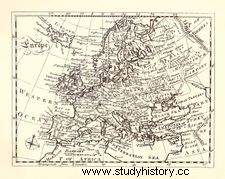Holland , historical region of the Netherlands, divided into the provinces of North Holland (North Holland) and Zuidholland (South Holland) since 1840. It forms the flat, low-lying northwestern part of modern country.
 Read more about this topic History of Europe:Holland In 1664, the English ambassador Sir George Downing described the constitution of the United Provinces as "such a shattered and divided thing". ...
Read more about this topic History of Europe:Holland In 1664, the English ambassador Sir George Downing described the constitution of the United Provinces as "such a shattered and divided thing". ... Holland originated in the early 12th century as a fief of Holy Roman Empire and was replaced by a Dynasty by counts rules which traced its origins back to the 9th century. These nobles had reappeared in the 10th century after the Vikings' destruction of the coast had ended, and they gradually expanded their territory of what is now North Holland northwards at the expense of the Frisians East and South, which involved them in a series of wars with the bishops of Utrecht . The name Holland may derive from the region Dordrecht from , which was known as Holtland ("woodland").
Dirk III, the third in the line of early counts of Holland, conquered much of what is now present-day from the bishops of Utrecht South Holland. In 1018 he defeated their forces and an imperial army at Vlaardingen, a fortress he had built to collect tolls on traffic in the Meuse Delta (Meuse). Under Dirk's descendants, Holland reached its final frontiers in the 13th century, although 1323 Zeeland in Owned .
In 1170, Holland's physical form was altered by floods, devastation leading to the formation of the Zuiderzee (now the IJsselmeer). William II. , Count of Holland from 1234 to 1256, promoted land reclamation , pushed for the maintenance of waterways and levees, and promoted community development by serving the growing cities of the county Trading privileges granted . He was 1247 by the opponents Conrad IV. In Germany elected king of Germany . The family lineage of the ancestor of the House of Holland, Dirk I (who had received the original feudal lands from the Carolingian Charles III the Simple in 922) remained until 1299 - a line of 14 offspring. At that time John I of Avesnes, Count of Hainault and a relative of John I, the last of the ancient house of Counts of Holland, adopted the title John II From Holland connecting Holland to Hainault in the south.
During the subsequent reign of House Avesnes, economic prosperity was fostered by extensive land reclamation, and cities benefited from growing trade and and fisheries. A controversial successor to the death of William IV (1345) led to a prolonged civil war between factions identified as Hooks (Hoeken) and the cod (cods), who represented rival aristocratic and bourgeois parties. The problem eventually resolved with the intervention of House Wittelsbach , whose members served as counts of Holland, Zeeland and Hainaut until they were forced to relinquish the titles Philip III. The Good Duke of Burgundy, 1433.
Under the Burgundian line, Holland's material prosperity increased steadily due to the flourishing herring fisheries and the development of the transport trade. Under Philip's son Carl the bold, Holland, however, suffered from high taxes, and after Charles' death in 1477 and the collapse of the central government left Holland along with other Burgundian possessions passed to the Habsburgs (1482). Philipp IV the Handsome (Philip I of Spain), grandson of Charles the Bold, came of age in 1494, and the territory Hollands prospered under his rule for 12 years. After his death, his son Charles II (later Roman Emperor Charles V) succeeded him. 1555 thanks Charles from Dutch rule in favor of his son, the future Philip II. From Spain.
In 1559 William I. of Orange (William the Silent) was appointed stadtholder of Holland, Zeeland and Utrecht by Philip II. Under William's leadership, Holland and Zeeland became the center of the uprising of the Netherlands against in 1572 Spain . Holland, along with the six other northern Dutch provinces, declared its independence from Spain in 1579 and proclaimed the United Provinces of the Netherlands. The last remnants of the old order disappeared in late 1587, when Holland was one of the sovereign provinces of the seven United Provinces. The province of Holland was ruled by her in the 17th and 18th centuries States . After 1608 this assembly consisted of 19 delegations, one representing the nobility and 18 representing the towns, each having one vote. Important issues such as peace and war, voting on subsidies, and imposing taxes required unanimous approval in the estates. When the Estates were not in session, the permanent supervision of the province was entrusted to a group of deputy councilors, charged with its general administration and with the implementation of the decisions of the stands commissioned.
In the 17th century Holland was the dominant power in the Dutch Republic and for the next 100 years the capital became Amsterdam to main trading center Europe . Because of this dominance, both the Republic and today's Kingdom of the Netherlands are often referred to as "Holland". but this name, as it applies to the whole country, only applies to the Napoleonic Kingdom of Holland, which occupied the territory of the old republic between 1806 and 1810. See also North Holland ; South Holland .
